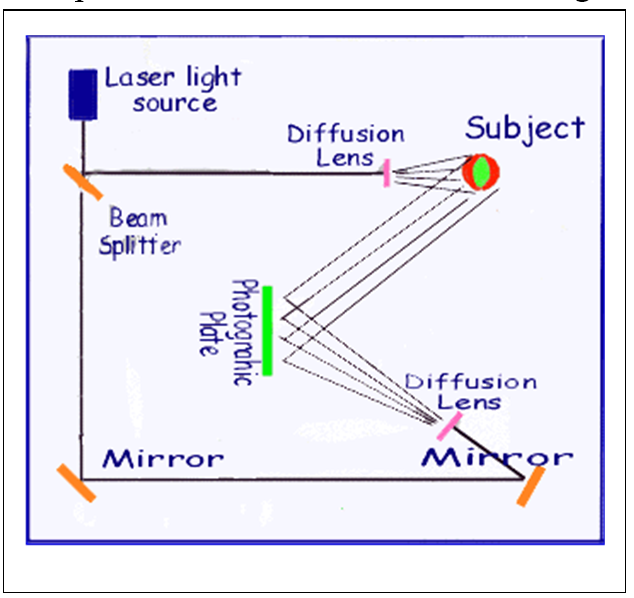
Our eyes see depth because light from different distances reaches our eyes slightly out of phase. Photos only store light intensity, so they don’t show depth, but holograms can show depth by storing the phase differences that encode it. A hologram is made by splitting laser light and letting the half that shines on the object interfere with the other half, to give a pattern (Figure 3.24). Light later shone on that pattern recreates the original object as a hologram.
The holographic principle is that we observe our universe like a hologram, or more precisely:
“Everything physically knowable about a volume of space can be encoded on a surface surrounding it” (Bekenstein, 2003).
This principle, widely accepted in physics, is that everything we observe about our world can be encoded on a flat surface, just like a hologram. The information in a space seems to depend on its volume, but if more and more memory chips are packed into a space, to increase its information, the end result is a black hole whose entropy depends on its surface area, not its volume.
Entropy in physics measures system disorder but also relates to information. A black hole has more entropy than anything else for its volume, and the information it contains depends on its surface area not its volume, so the holographic principle is maintained by the behavior of black holes (Bekenstein, 2003).
It is therefore interesting that if our world is virtual, the same result applies. Every virtual event has to be observed from some direction, so the act of observing uses up one dimension of space, which leaves only two dimensions to transfer information. This means that the information transferred to a point in a three-dimensional virtual world can always be painted on the surface of a sphere around it, because that is how it is delivered. That our world is virtual then requires the holographic principle, and conversely, that the holographic principle applies in our world suggests that it is virtual.
The holographic principle doesn’t make our world two-dimensional. That it presents in two dimensions doesn’t mean it operates as such, so space still has three degrees of freedom. It applies because every observation comes from some direction so there are only two dimensions to deliver information across. The holographic principle describes how physical events are observed, not how space works.
Equally to imagine that our world is like a Star Trek hologram that we can enter and leave at will is misleading. Our bodies are its images, so if we left this hologram, or if it ever switched off, our bodies would disappear, along with everything else physical. The only way then to recover it would be to start it again from the beginning, which was over fourteen billion years ago.